First Look: Samsung Galaxy S8
by Matt Humrick on April 21, 2017 8:55 AM EST- Posted in
- Smartphones
- Samsung
- Galaxy
- Mobile
- Snapdragon 835
- Galaxy S8
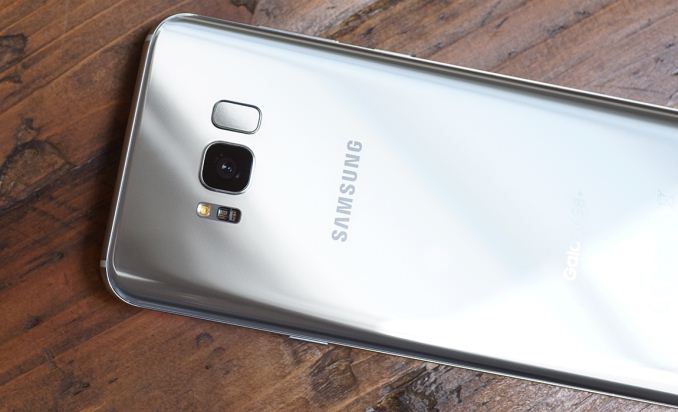
We first saw Samsung’s new 5.8-inch Galaxy S8 and 6.2-inch Galaxy S8+ at its Unpacked event a few weeks ago. During the event, we saw demos of its new virtual assistant, Bixby, and its DeX docking station, which allows the Galaxy S8 to provide a desktop-like experience by connecting to an external monitor and peripherals, but we didn’t have much time with the phones to do much more than take some pictures and try a couple of the new features. After receiving a Galaxy S8 earlier this week, we wanted to give you some feedback about its design and biometric features, as well as, an initial performance and battery life assessment before we dive into our usual in-depth testing.
My biggest complaint about the design is the location of the fingerprint sensor, which I discuss in the video above. It has been relocated to the back next to the camera, making it difficult to reach and use. The new face unlock feature, the second of the S8’s three biometric authentication options, is flawed too. Despite my best efforts, I was not able to get face unlock to work, not even once. The feature, which relies solely on the front-facing camera for identification, also is not very secure, assuming it works at all. It has already been shown that simply holding a picture in front of the camera is enough to fool it into unlocking the phone. The camera really needs to be augmented with an infrared camera to detect a face’s heat signature as a liveness test, or a second, depth-sensing camera to at least detect a face in three dimensions. So far the iris scanner, which I also demo in the video above, has proven to be the easiest and most reliable biometric option.
| Samsung Galaxy S8 Series | ||
| Samsung Galaxy S8 | Samsung Galaxy S8+ | |
| SoC | Qualcomm Snapdragon 835 (US, China, Japan) 4x Kryo 280 Performance @ 2.35GHz 4x Kryo 280 Efficiency @ 1.90GHz Adreno 540 Samsung Exynos 8895 (rest of world) 4x Exynos M2 @ 2.30GHz 4x Cortex-A53 @ 1.70GHz ARM Mali-G71 |
|
| Display | 5.8-inch 2960x1440 (18.5:9) SAMOLED (curved edges) |
6.2-inch 2960x1440 (18.5:9) SAMOLED (curved edges) |
| Dimensions | 148.9 x 68.1 x 8.0 mm 155 grams |
159.5 x 73.4 x 8.1 mm 173 grams |
| RAM | 4GB LPDDR4 (US) | |
| NAND | 64GB (UFS) + microSD |
|
| Battery | 3000 mAh (11.55 Wh) non-replaceable |
3500 mAh (13.48 Wh) non-replaceable |
| Front Camera | 8MP, f/1.7, Contrast AF | |
| Rear Camera | 12MP, 1.4µm pixels, f/1.7, dual-pixel PDAF, OIS, auto HDR, LED flash | |
| Modem | Snapdragon X16 LTE (Integrated) 2G / 3G / 4G LTE (Category 16/13) Samsung LTE (Integrated) 2G / 3G / 4G LTE (Category 16/13) |
|
| SIM Size | NanoSIM | |
| Wireless | 802.11a/b/g/n/ac 2x2 MU-MIMO, BT 5.0 LE, NFC, GPS/Glonass/Galileo/BDS | |
| Connectivity | USB Type-C, 3.5mm headset | |
| Features | fingerprint sensor, heart-rate sensor, iris scanner, face unlock, fast charging (Qualcomm QC 2.0 or Adaptive Fast Charging), wireless charging (WPC & PMA), IP68, Mobile HDR Premium | |
| Launch OS | Android 7.0 with TouchWiz | |
Inside the redesigned Galaxy S8 and S8+ is either a Qualcomm Snapdragon 835 or Samsung Exynos 8895 SoC. The US and other regions that require CDMA capability will get the Snapdragon 835, while the rest of the world will get Samsung’s SoC. The new 10nm SoCs are paired with 4GB of LPDDR4 RAM and 64GB of UFS 2.1 NAND. The Galaxy S8 comes with a 3000mAh battery, the same size as the Galaxy S7, while the S8+ comes with a 3500mAh battery, slightly less than the S7 edge’s 3600mAh capacity.
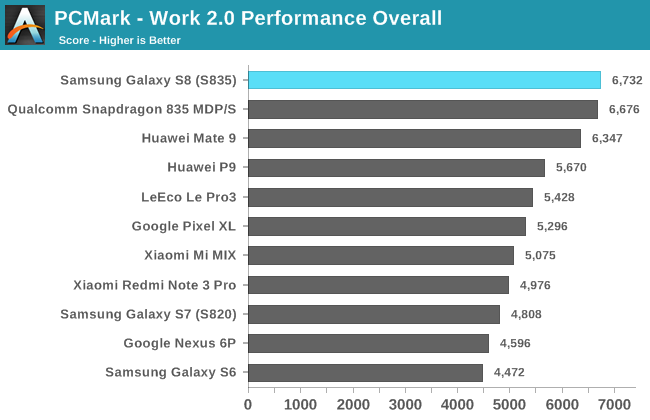
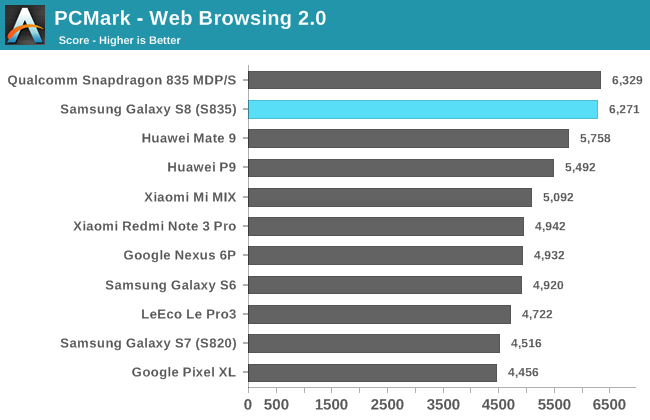
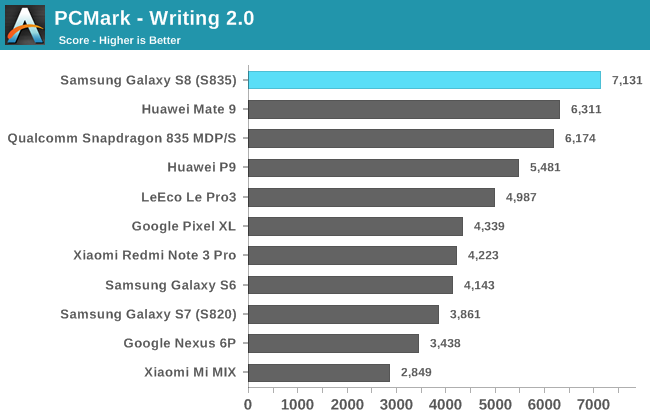
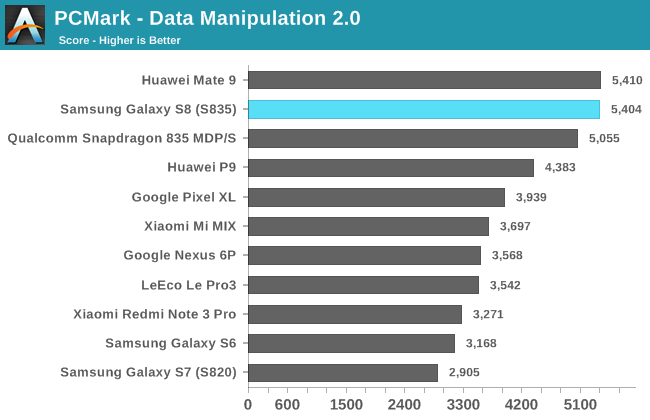
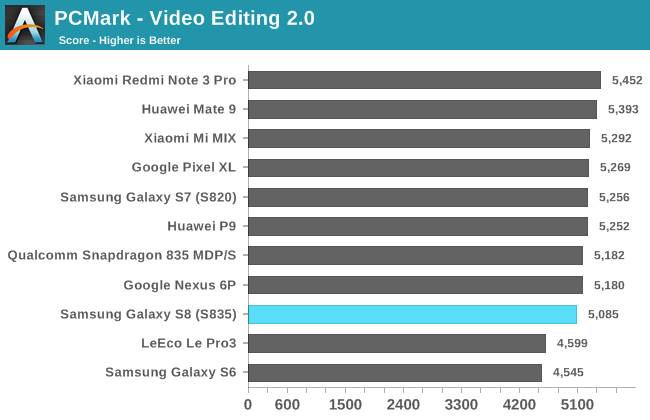
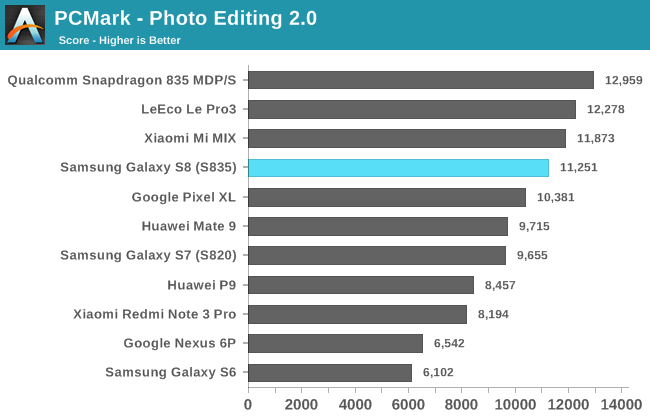
In PCMark, which is our best indicator of general system performance, the Galaxy S8 with Snapdragon 835 performs quite well, besting even the Mate 9 overall. Because this is the first S835 retail device we’ve tested, I’ve also included Qualcomm’s Snapdragon 835 MDP/S, which the company uses internally for hardware testing and software development, as a reference point. In most of these tests, the Galaxy S8 performs about the same as the Snapdragon 835 MDP/S, which is certainly a good sign.
The Galaxy S8 does particularly well in the Writing test, outscoring the Mate 9 by 13% and the Galaxy S7 (Snapdragon 820) by 85%. The Writing test, which previous Galaxy phones struggle with, uses a fairly bursty workload, frequently migrating threads between the little and big cores. Perhaps this is an indication that Samsung is utilizing the big cores more aggressively than in the past. The Galaxy S8 is also 9% faster than the Mate 9 in the Web Browsing test and 37% faster than the S7 (S820).

The Galaxy S8 achieves over 8 hours of screen-on-time while continuously crunching through the PCMark workloads, 46% longer than the Galaxy S7 that has the same 3000mAh battery, which suggests some nice efficiency gains from the new SoC, display, or other components. While the Galaxy S7 can struggle to last a full day on a single charge depending on how it’s used, these initial results suggest the Galaxy S8 will encounter fewer scenarios where it will need to use its fast charging or wireless charging abilities to stretch battery life till the end of the day.
While we’ve only had the Galaxy S8 for a couple of days, our first impression is generally positive. It’s packed with features, TouchWiz is more refined, and it performed well in our first performance and battery life tests. A few issues are already apparent, however. Your face probably will not be smiling if you try to rely on it to unlock the phone, and the fingerprint sensor is located in just about the worst possible place. Samsung’s Bixby assistant also is not yet fully functional; fortunately, you can still use Google Assistant while you’re waiting for Bixby to mature.










129 Comments
View All Comments
dstarr3 - Friday, April 21, 2017 - link
The charging method doesn't at all make a removable battery irrelevant. The problem is that batteries can only be recharged so many times, and in every single phone I've owned, it was the battery that was the first part to fail. Sometimes even the only part to fail, in phones that I upgraded simply because of age of technology. But now, when the battery fails, which it will, the entire phone is junk. And there is no way I'm spending $600-$800 on a phone that I'll only get 2-3 years of use out of, max.Honestly, if I have to spend the rest of my life using dumb-phones because of this, I will. Cell phones are not worth the money they cost when considering the frequency with which they need to be replaced now.
Meteor2 - Friday, April 21, 2017 - link
The problem I had with replaceable batteries is that by the time the OEM battery had lost so much capacity I wanted to replace it, the only batteries I could get were cheap knock-offs which actually had less capacity than the tired original battery :(.TBH I don't mind spending that kind of money (well, the bottom end) every two or three years, as the tech moves on so far in that span of time.
lilmoe - Friday, April 21, 2017 - link
Good practice would be buying an extra battery regardless of the health of the original battery. I did that for non replaceable s7 battery and it's kept safe in the box. I'll need it someday. I wouldn't mind trading water resistance after replacing the battery for extending the life of the device an additional 2- 3 yearsgrant3 - Friday, April 21, 2017 - link
A lithium battery in storage will permanently lose ~3% of capacity, depending on temperature.grant3 - Friday, April 21, 2017 - link
There are plenty of smartphones available for much less than $600-$800.Yongsta - Friday, April 21, 2017 - link
I've had the One Plus One and Iphone 6 for 3 years now, the battery life still is great on both phones. I'm looking for an upgrade this year but batteries now can be recharged so many times without any issue. My old Samsung Galaxy Note 2 phone I used for 2 years and gave to my mom 2 years ago, it's near 5 years old and battery life is still fine.philehidiot - Saturday, April 22, 2017 - link
I've got a HTC M9. The battery life was borderline acceptable at birth but now, 20 or so months later it requires charging twice a day and I've got to carry a portable charger. Granted I use it a fair amount but it's still unacceptable. Compare that to my girlfriend's new S7 and that lasts to the end of the day with 60%+ (although her use is less than mine). Whilst yes, mine has the problem of the S810 SoC, I still think this classifies as making a product unfit for purpose. If it can't be used properly (and those of us who pay for a flagship phone are not exactly going to be leaving it in our pockets, nor should you, in my opinion, have to cripple it by turning off all the high speed cores or reducing the screen brightness to squint inducing levels) for the life of the contract it is tied to then it's not fit for purpose.I think part of the problem is the obsession with fast charging. I don't see the point in it most of the time as you're recharging it overnight (as long as the damn thing lasts the day, if it's a mid day recharge then it's from my portable battery which is only 1A max output anyway). I think the default charging method should be a slow charge to minimise heat and battery degradation. When you connect it to a compatible charger a drop down notification could easily pop up asking if you want to fast charge or not. As a result of this perceived problem (which some people on this site have confirmed is an issue and the advancements being advertised by one of the Chinese firms (I forget which one) seem to also confirm) I now connect my phone to a 1A output charger for overnight charging and only to a higher output when I need a quicker charge. I think in my case the damage is already done and the horse bolted so long ago the stable has been demolished and the door is for sale on ebay.
Perhaps I will abandon my love affair with HTC and go for a Samsung next time around as they finally appear to have stopped bastardising the interface so much and my experience with the S7 is just so much better than the M9. The camera latency is just incredible as is the screen. Plus the battery improvements. I'm not sure if the S8 is worth it for me but the S7 might be nice and cheap soon....
serendip - Sunday, April 23, 2017 - link
Fast charging isn't bad as long as you keep temperatures down. I'd also limit the depth of discharge and maintain state of charge between 40-80%, with 100% charge only used on occasionally when you really need that power. Limited discharge means longer cycles before total capacity goes down, so you could still see something like 90% capacity after 2 years.m2inor - Wednesday, April 26, 2017 - link
Perhaps the cell phone companies could learn something from Toyota about charging and maintaining batteries.Anyone owning a hybrid car will typically drive their car everyday, and the battery is charged and discharged several times per day.
When I read about Toyota's battery management, I learned several things:
- NiMH instead of Lithium
- batteries only permitted to discharge to 10-20%
I have 10 years on my RX400h, and all is still doing well. I asked the dealer how many batteries they've had to replace since the vehicle was introduced back in 2006. 1, and that was due to an accident that damaged the battery.
I've had a Samsung Note 3 for several years but I had been using a double sized battery with a flip case from Seidio. That's what it takes to get thru the day on one charge. The 3rd party battery is finally starting to show its age, and I purchased a spare battery at same time. 3+ years of life.
Just switched to S7 Edge / 128GB version that Samsung is selling in the UAE. Great phone. Was tempted by the S8 and S8+ but that Edge did everything I cared about for a few hundred dollars less.
Too bad Samsung limits the market of their premier phones. Yes, dual SIM versions of the S8/8+ are being offered in UAE and other Asian markets, but not 128GB yet. I was pleasantly surprised that my S7 Edge 128GB ad some of the S8 improvements, too, and came with Nougat 7.0 already installed.
marcplante - Sunday, May 14, 2017 - link
Some of us don't mind keeping a phone for 3-4 years. I have been able to do that because I could update the battery at 2 years. If my s5 had 32gb of memory, I'd probably hold onto it for a couple more years, but I bought an s8 and this will be retired as a nice tv remote. I'm gonna miss the ir blaster in the phone.